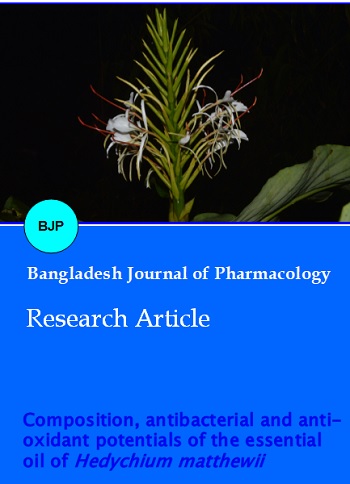Composition, antibacterial and anti-oxidant potentials of the essential oil of Hedychium matthewii
DOI:
https://doi.org/10.3329/bjp.v12i2.29339Keywords:
Antibacterial, Anti-oxidant, Essential oil, Hedychium matthewiiAbstract
Essential oils are known for their medicinal value since time immemorial and continue to be of vital importance until the present day. The present study describes the composition, antibacterial and anti-oxidant potential of rhizome oil of Hedychium matthewii. Thirty-five constituents of the oil were identified to account for 82.7%, of which 85.7% was monoterpes and the rest were sesquiterpnes. Most of the major constituents were alcohols and linalool was the prominent one (45.7%). The antibacterial assay showed the bactericidal effect of the essential oil and the most susceptible organism was Streptococcus hemolyticus with a zone of inhibition of 33.8 ± 1.7 mm. The reducing power and nitric oxide scavenging activity of the essential oil was far exceeding the reference compound ascorbic acid and it could be the sign of the potential anti-oxidant power of the oil isolated. The present study also revealed the prospective of H. matthewii as a new natural source of linalool, which has medicinal and various industrial applications.
Downloads
134
173 Read
35

Published
How to Cite
Issue
Section
License
Authors who publish with this journal agree to the following terms:
- Authors retain copyright and grant the journal right of first publication with the work simultaneously licensed under a Creative Commons Attribution License that allows others to share the work with an acknowledgement of the work's authorship and initial publication in this journal.
- Authors are able to enter into separate, additional contractual arrangements for the non-exclusive distribution of the journal's published version of the work (e.g., post it to an institutional repository or publish it in a book), with an acknowledgement of its initial publication in this journal.
- Authors are permitted and encouraged to post their work online (e.g., in institutional repositories or on their website) prior to and during the submission process, as it can lead to productive exchanges, as well as earlier and greater citation of published work (See The Effect of Open Access).
